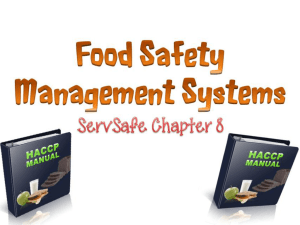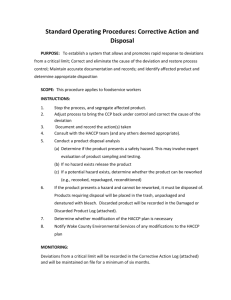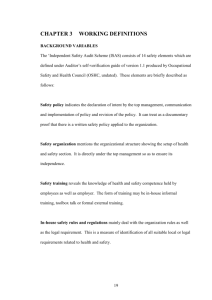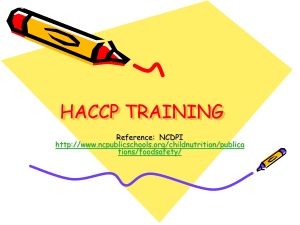Introduction to HACCP - Rockcastle County Schools
advertisement
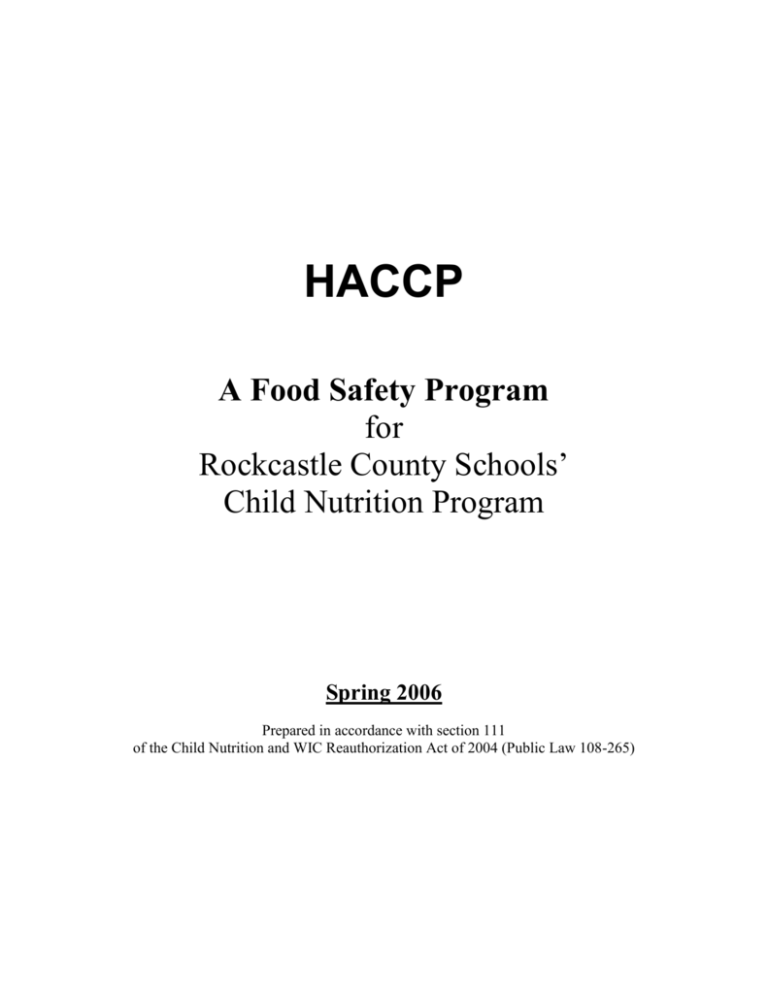
HACCP A Food Safety Program for Rockcastle County Schools’ Child Nutrition Program Spring 2006 Prepared in accordance with section 111 of the Child Nutrition and WIC Reauthorization Act of 2004 (Public Law 108-265) Introduction Section 111 of the Child Nutrition and WIC Reauthorization Act of 2004 (Public Law 108-265) amended section 9(h) of the National School Lunch Act by requiring school food authorities (SFAs) to implement a food safety program for the preparation and service of school meals served to children in the school year beginning July 1, 2005. The program must be based on Hazard Analysis and Critical Control Point (HACCP) principles and conform to guidance issued by the Department of Agriculture (USDA). All SFAs must have a fully implemented food safety program that complies with HACCP principles no later than the end of the 2005 – 2006 school year. This document is based on the elements that USDA identified as the requirements necessary for the implementation of HACCP-based food safety programs in schools participating in the National School Lunch Program (NSLP) or the School Breakfast Program (SBP). HACCP is a systematic approach to construct a food safety program designed to reduce the risk of foodborne hazards by focusing on each step of the food preparation process – from receiving to service. USDA recommends that SFAs use the Process Approach to HACCP because it gives more flexibility to create a program suitable for a variety of situations. The Process Approach categorizes food preparation into three broad categories based on how many times each menu item moves through the temperature danger zone. Serving safe food is a critical responsibility for school foodservice and a key aspect of a healthy school environment. Keeping foods safe is also a vital part of healthy eating and a recommendation of the Dietary Guidelines for Americans 2005. When properly implemented, HACCP-based food safety programs will help ensure the safety of the school meals served to children across the Nation. Overview All schools that participate in the National School Lunch Program and/or the School Breakfast Program must implement a food safety program. The food safety program must include a written plan for each individual school in the SFA and be based on HACCP principles. There are three main points essential to the development of a food safety program: sanitation, temperature control, and Standard Operating Procedures (SOPs). 1. Food preparation areas must be clean and sanitary. This should include the workers’ hands, utensils, and food contact surfaces. Avoid cross contamination. 2. Temperature control means keeping cold foods cold and hot foods hot. Cook to proper temperatures and hold at proper temperatures, and be sure to record those temperatures. A basic, properly calibrated food thermometer is all that’s needed to check for proper temperatures. 3. SOPs can be used both for sanitation and to verify that proper temperatures are being observed, as well as other aspects of a foodservice operation. The following are some new terms associated with the food safety program and individual school plans: Hazard analysis: review of the school’s food service operation to find areas where food safety problems might occur Control measures: steps taken to reduce the likelihood of food contamination Critical control points: points in food preparation and processing where controlling a step (such as cooking) is essential to assure food safety Critical limits: the time and temperature ranges for food preparation and service (either cold or hot) that keep food safe Process Approach: a method of grouping menu items into one of three processes depending on the number of times the food goes through the temperature “danger zone:, which is between 41F and 135F (per the amendment to the 2001 FDA Food Code issued in August 2003) Standard Operating Procedure (SOP): written instructions for a food service task that reduce food safety hazards Rockcastle County Schools’ food service will have a food safety program based on the Process Approach to HACCP. This program follows the USDA guidance on developing a food safety program. All standards in the food safety program are based on recommendations in the 2001 Food Code. The manager will be responsible for checking at least monthly to see that it is working. Any problems with sanitation or temperature control will be corrected. Every year the program will be reviewed and any necessary changes will be incorporated. Purpose of a School Food Safety Program The purpose of a school food safety program is to ensure the delivery of safe foods to children in the school meals program by controlling hazards that may occur or be introduced into foods anywhere along the flow of the food from receiving to serving. An effective food safety program will help control food safety hazards that might arise during all aspects of food service (receiving, storing, preparing, cooking, cooling, reheating, holding, assembling, packaging, transporting, and serving). There are two types of hazards: (1) one is specific to the preparation of foods, such as improper cooking for the specific type of food (beef, chicken, eggs, etc.) and (2) nonspecific one that affects all foods, such as poor personal hygiene. Specific hazards are controlled by identifying Critical Control Points (CCPs) and implementing measures to control the occurrence or introduction of those hazards. Nonspecific hazards are controlled by developing and implementing SOPs. A school food safety program should control both specific and nonspecific hazards. The program should consist of SOPs and a written plan for applying the basic HACCP principles. Requirements of a School Food Safety Program The Rockcastle County School District is responsible for developing a comprehensive food safety program for the schools, including a plan for every school food preparation and service site. A school food safety program must include the following elements: 1. Documented Standard Operating Procedures (SOPs) SOPs are a very important factor in developing an effective food safety program. Their roles are to serve as basic food safety foundations and to control hazards not outlined specifically in the HACCP plan. For example, soiled and unsanitized surfaces of equipment and utensils should not come into contact with raw or cooked (ready-to-eat) food. Proper procedures to prevent this occurrence should be covered by an SOP. 2. A written plan at each school food preparation and service site for applying HACCP principles that includes methods for: Documenting menu items in the appropriate HACCP process category Documenting Critical Control Points of food production Monitoring Establishing and documenting corrective actions Recordkeeping Reviewing and revising the overall food safety program periodically Implementation of HACCP For Rockcastle County Schools’ Food Service I. Documented Standard Operating Procedures (SOPs) SOPs are a very important factor in an effective food safety program. Their role is to serve as a basic food safety foundation and to control hazards not outlined specifically in the HACCP plan. For example, soiled and unsanitized surfaces of equipment and utensils should not come into contact with raw or cooked (ready-toeat) food. Proper procedures to prevent this occurrence are covered by an SOP. See Standard Operating Procedures for Rockcastle County Schools. (see Standard Operating Procedures) HACCP-based SOPs include the following principles: Corrective actions Monitoring procedures Verification procedures Record keeping procedures II. Documented Process Approach to Food Preparation Food items are listed according to how they are prepared: (1) kept cold from preparation through service; (2) prepared hot and served the same day hot; and (3) prepared hot and served cooled, or possibly reheated. These are the preparation categories in the Process Approach to HACCP. The Process Approach is a method of classifying food preparation into three categories. These categories are based on the number of times a menu item makes a complete trip through the temperature danger zone. The way food is prepared at each site determines into which of the three food preparation processes it will fall. Each menu item for the Rockcastle County Schools is identified by the number of times that it goes up (heating) or comes down (cooling) through the danger zone (41F - 135F) and is classified into the following food preparation processes: Process #1 – No Cook The menu item does not go completely through the danger zone in either direction. Process #2 – Same Day Service The menu item takes one complete trip through the danger zone (going up during cooking) and is served. Process #3 – Complex Food Preparation The menu item goes through both heating and cooling, taking two or more complete trips through the danger zone. III. Documented Critical Control Points (CCP) and Critical Limits In addition to identifying the appropriate process for each menu item, necessary control measures are determined to prevent the introduction of hazards at each stage of food preparation from receiving to service. Control measures are any means taken to prevent, eliminate, or reduce hazards. These measures include SOPs, as well as the Critical Control Points (CCPs), and the corresponding critical limits established in each of the three processes. A Critical Control Point is a key point where a step can be taken to prevent, eliminate, or reduce a food safety hazard to an acceptable level. Critical Control Points are established for all food items served in the Rockcastle County Schools. The following are CCPs, related to each food preparation process: For Process #1 – No Cook: Cold holding or limiting time in the danger zone to inhibit bacterial growth and toxing production (e.g., limiting time would be holding at room temperature for 4 hours and then discarding) For Process #2 – Same Day Service: Cooking to destroy bacteria and other pathogens Hot holding or limiting time in the danger zone to prevent the outgrowth of spore-forming bacteria For Process #3 – Complex Food Preparation: Cooking to destroy bacteria and other pathogens Cooling to prevent the outgrowth of spore-forming bacteria Hot and cold holding or limiting time in the danger zone to inhibit bacterial growth and toxin formation Reheating for hot holding, if applicable Each CCP includes boundaries that define safety. These boundaries or critical limits are the time and/or temperatures that must be achieved or maintained to control a food safety hazard. When critical limits are not met, the food may not be safe. Critical limits (time/temperature) are measurable and observable. The 2001 FDA Food Code (as amended August 2003) provides critical limits designed to prevent, eliminate, or reduce hazards in food. (see SOP Cooking Potentially Hazards Foods) Process and temperature charts for the day’s menu items are posted daily in the kitchen by the manager. In addition, the menu cycle, recipes, product directions, and charts are kept in the manager’s office. (see Food Preparation Process Charts) IV. Established Monitoring Procedures Monitoring is an important step for an effective food safety program. Control measures, including CCPs and SOPs, must be monitored, controlled, and documented in writing. Monitoring involves making direct observations or taking measurements to see that the food safety program is being followed. Monitoring will identify when there is a loss of control so that corrective action can be taken. Final temperature and time measurements must be effectively monitored at the critical limits for them Equipment appropriate for the monitoring function must be chosen. Monitoring interval must be reliable enough to ensure hazards are being controlled. Procedures for monitoring must be simple and easy to follow. Employees responsible for monitoring must be given the training and equipment necessary to properly perform the monitoring activities. V. Established corrective actions Whenever a critical limit is not met, a corrective action must be carried out immediately. A corrective action may be simply continuing to heat food to the required temperature. Other corrective actions may be more complicated, such as rejecting food items that were not delivered at the right temperature or discarding food that has been held without temperature control too long. This preventive approach is the heart of HACCP. Food Service employees must know what corrective actions are and be trained in making the right decisions. VI. Recordkeeping Certain written records or kinds of documentation are needed to verify that the food safety program is working. These records involve the food safety plan and any monitoring, corrective action, or calibration records produced in the operation of the food safety program based on HACCP principles. Recordkeeping provides a basis for the periodic reviews of the program. Documentation should be kept as simple as possible. Each food item will have a recordkeeping form established which will show CCPs and SOPs in each of the processes. VII. Review and revise There will be ongoing as well as a periodic review of the food safety program. This ensures that the food safety program is operating according to what the plan says. This review will occur at least annually or as often as necessary to reflect any changes in the food service program. These changes may include new equipment, new menu items, reports of illness, or other factors that indicate how well our food safety program is working. The school food service manager will be responsible for reviewing the school food safety program at the beginning of each school year and when any significant changes occur in the operation. The manager’s checklist and the food safety checklist will be used for the review. (see Manager’s Checklist and Food Safety Checklist)
